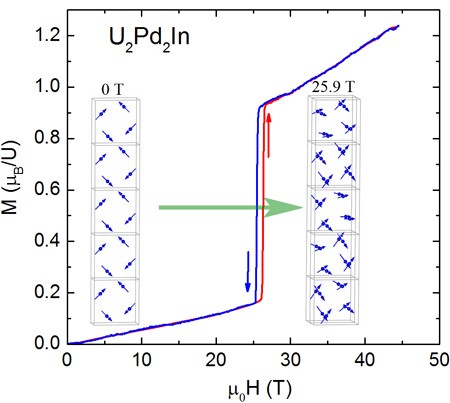Not everything is ferromagnetic in high magnetic fields

Bei 25,8 Tesla findet in dem Urankristall ein Phasenübergang statt und ein komplexes magnetisches Muster etabliert sich. © HZB
High magnetic fields have a potential to modify the microscopic arrangement of magnetic moments because they overcome interactions existing in zero field. Usually, high fields exceeding a certain critical value force the moments to align in the same direction as the field leading to ferromagnetic arrangement. However, a recent study showed that this is not always the case. The experiments took place at the high-field magnet at HZB's neutron source BER II, which generates a constant magnetic field of up to 26 Tesla. This is about 500,000 times stronger than the Earth's magnetic field. Further experiments with pulsed magnetic fields up to 45 Tesla were performed at the Helmholtz-Zentrum Dresden-Rossendorf (HZDR).
The physicists examined crystals of U2Pd2In, which form a special class of solids (Shastry-Sutherland system). The interactions between the magnetically active uranium atoms are quite complex in this structure, mainly due to the extended 5f orbitals of the outermost electrons of uranium in a solid. These 5f electrons are also carriers of the magnetic moment in the material.
Using neutron diffraction in strong fields they found that an unusually complicated non-collinear modulated magnetic structure above a critical magnetic field. The magnetic unit cell is twenty times larger than the crystallographic unit, containing 80 magnetic moments. Such a structure is a consequence of competition between different strong interactions and the applied field. “Our results are important from two reasons”, Dr. Karel Prokes (HZB) says. “First, they show that the field induced phase is not ferromagnetic and the magnetization increase at high fields is probably due to a gradual rotation of U moments towards the field direction, a finding that might be of relevance for many other systems and second, they may help to develop more precise theories dealing with 5f electron systems”.
Phys. Rev. Research (2020): Noncollinear magnetic structure in U2Pd2In at high magnetic fields.
K. Prokeš, M. Bartkowiak, D. I. Gorbunov, O. Prokhnenko, O. Rivin, and P. Smeibidl
DOI: 10.1103/PhysRevResearch.2.013137
arö
https://www.helmholtz-berlin.de/pubbin/news_seite?nid=21022;sprache=en
- Copy link
-
Peat as a sustainable precursor for fuel cell catalyst materials
Iron-nitrogen-carbon catalysts have the potential to replace the more expensive platinum catalysts currently used in fuel cells. This is shown by a study conducted by researchers from the Helmholtz-Zentrum Berlin (HZB), Physikalisch-Technische Bundesanstalt (PTB) and universities in Tartu and Tallinn, Estonia. At BESSY II, the team observed the formation of complex microstructures within various samples. They then analysed which structural parameters were particularly important for fostering the preferred electrochemical reactions. The raw material for such catalysts is well decomposed peat.
-
Helmholtz Investigator Group on magnons
Dr Hebatalla Elnaggar is setting up a new Helmholtz Investigator Group at HZB. At BESSY II, the materials scientist will investigate so-called magnons in magnetic perovskite thin films. The aim is to lay the foundations for future terahertz magnon technology: magnonic devices operating in the terahertz range could process data using a fraction of the energy required by the most advanced semiconductor devices, and at speeds up to a thousand times faster.
-
Long-term stability for perovskite solar cells: a big step forward
Perovskite solar cells are inexpensive to produce and generate a high amount of electric power per surface area. However, they are not yet stable enough, losing efficiency more rapidly than the silicon market standard. Now, an international team led by Prof. Dr. Antonio Abate has dramatically increased their stability by applying a novel coating to the interface between the surface of the perovskite and the top contact layer. This has even boosted efficiency to almost 27%, which represents the state-of-the-art. After 1,200 hours of continuous operation under standard illumination, no decrease in efficiency was observed. The study involved research teams from China, Italy, Switzerland and Germany and has been published in Nature Photonics.
